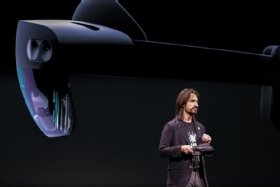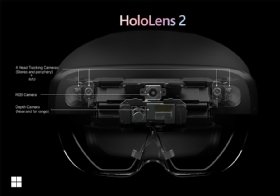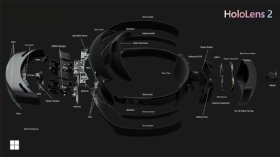
andreaobzerova - stock.adobe.com
Time is money: Microsoft's HoloLens 2 saves both
The Microsoft HoloLens 2 headset has yet to reach wide adoption among enterprises. But organizations that have embraced it have found that the AR product saves time and cuts costs.
At the height of the COVID-19 pandemic last year, the U.K. struggled to equip hospitals with ventilators -- the life-saving technology that pumped oxygen into the lungs of people ravaged by the virus.
Rab Scott, head of digital initiatives at the University of Sheffield Advanced Manufacturing Research Centre (AMRC), drove around the country delivering Microsoft's HoloLens 2 devices to manufacturers like Airbus and Rolls-Royce. The augmented reality (AR) headsets would be critical to teaching workers how to make roughly 13,500 life-saving ventilators in the battle against the pandemic.
"We used the HoloLens because it allowed us to provide rapid upskilling of the workforce," Scott said. "We were teaching people that previously made car engines [how] to make a ventilator."
Since its unveiling in 2019, various organizations have used the $3,500 HoloLens 2 for training, car manufacturing, and scientific and medical research. Proponents say the device saves time, cuts costs and makes numerous tasks more efficient.
The list of organizations using the HoloLens is long and growing. Blackpool Teaching Hospitals use the device to let more students join clinical observations. Carnegie Mellon University (CMU) explores how students learn through experiments with the HoloLens. Ecolab remotely analyzes water samples, Toyota Motor Corp. repairs vehicles, and Gaumard Scientific does medical simulations -- all with the help of the HoloLens.
Yet, the technology isn't perfect, users said. Its reliance on Wi-Fi means some features won't work in dead zones. For example, students can hear only the physicians wearing the headset and not the patients they're addressing during hospital training sessions, said Caroline Bennison, senior education technologist at Blackpool.

Also, the field of view streaming from a HoloLens wearer looks like a low-budget film rather than a studio-produced movie. The shaky image can be frustrating to follow, said Jim Archetto, vice president at Gaumard.
The elephant in the room is the cost. Small businesses don't have the money to equip employees with the headset, and many larger companies see it as a risky investment.
Still, large manufacturers like Ecolab and Toyota can afford to be on the cutting edge. Teaching facilities like Blackpool and CMU apply for grants.
Sharing expertise faster
Overall, organizations using the HoloLens say they can live with the problems to reap the benefits.
AMRC trained Airbus assembly workers via HoloLens at the aerospace company's R&D facility in Wales, which it had transformed into a ventilator factory. The employees tinkered with their ventilators-to-be as experts in AMRC headquarters corrected them and explained where things went. One employee at could teach multiple Airbus employees, saving time and travel costs.


Ecolab, an infection prevention services company based in St. Paul, Minn., reduced travel expenses through an approach similar to AMRC's. Ecolab handed out about 100 HoloLens to employees in the field across the world. The devices helped guide microbiologists and chemical engineers through analyses and evaluations of water quality.
Ecolab engineers used to spend as much as 90% of their time on the road. With the HoloLens, they went from doing a few customer-site visits a week to several a day.
"It really is about any place any time to get the right expertise that you need in a much faster way than having them get on a plane to do it," said Kevin Doyle, vice president of commercial digital solutions at Ecolab.
The HoloLens helped Blackpool teaching and university hospitals in Morecambe Bay, England, offer more students clinical hours. The doctors-to-be watched the video stream from HoloLens-wearing clinicians as they treated patients. The students could ask questions and hypothesize on diagnoses without being in the room.
Bennison said Blackpool recently expanded its HoloLens use to physiotherapy, occupational therapy, dietetics, radiography and podiatry. The devices should let the Morecambe teaching hospital increase the number of occupational therapy students from seven to nine and physiotherapy trainees from 13 to 20 in the coming year.
Bennison plans to use the devices in surgery observations soon. "That would be the dream," she said. Blackpool would first need approval from government regulators.
Additional uses for HoloLens devices
What makes the HoloLens 2 stand out in a crowded pool of AR headsets is its ability to project 3D holograms of CAD models and pin them in place in the real world, experts said.
A Toyota repair technician using a HoloLens can see an engine and axle as a hologram overlaid on the real-world exterior of a vehicle. As a result, the person doesn't need a separate manual.
"It is easier to reference the necessary repair information, which increases work efficiency while reducing work errors by workers with less training and experience," said Koichi Kayano, project manager of mixed reality at Toyota. The company has deployed approximately 100 HoloLens units across its dealerships to help with repairs.
Medical simulation manufacturer Gaumard provides HoloLens devices alongside Microsoft Surface laptops and life-size humanoid robots. Users of the bundle include Massachusetts General in Boston and Columbia University's School of Nursing in New York.
In Gaumard's obstetrics and gynecology simulation, students practice a delivery using a female robot named Victoria that gives birth to a robot baby. Students use the HoloLens to see what the baby looks like in utero, helping them become accustomed to the many ways they can manipulate a child in the womb.
"What we're able to do using the HoloLens is provide visual clues," Archetto said.
Businesses have found that the HoloLens can be useful for helping customers understand how to use products. Ecolab field workers use it to help government agencies and large corporations determine the best locations for water-monitoring skids -- a large piece of equipment that comes with tanks and gauges.
Ecolab employees rotate and move hologram representations of skids to show the best locations for the devices. Doyle likened the task to an interior decorator using virtual software to show a homeowner where to place a couch. Using a virtual skid first avoids having a customer find out later that it doesn't fit inside a facility.
Because the HoloLens saves organizations time and money, it could one day graduate from a niche product to more mainstream technology, analysts said.
Tom Brannen, an analyst at OnConvergence, predicts the price tag for the HoloLens will decrease significantly over the next 24 months. Once that happens, architectural firms, retailers and others will start looking at the technology.
"There's not an industry that's not going to benefit from [the HoloLens]," Brannen said.
The U.K.'s rapid deployment of ventilators at the start of the pandemic would not have succeeded without the AR device, Scott said. Even if the AMRC had enough supervisors to send across the country, safety guidelines would have prohibited them from standing over the shoulder of an assembly worker.
Therefore, in the U.K., the HoloLens saved time, money, and lives.
Maxim Tamarov is a news writer covering mobile and end-user computing. He previously wrote for The Daily News in Jacksonville, N.C., and the Sun Transcript in Winthrop, Mass. He graduated from Northeastern University with a degree in journalism. He can be found on Twitter at @MaximTamarov.






